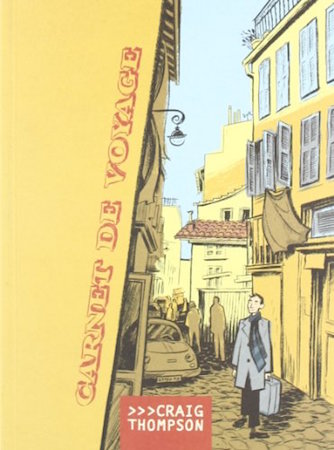Carnet de Voyage

While on a three-month research and promotional tour of France and Morocco, Craig Thompson made sketches and kept notes of his adventures, now published as this travel diary.
In Carnet de Voyage, his art is as lushly detailed as ever. Firm black lines with crayon or brush make up both full-page illustrations and more entertainingly cluttered pages, with thoughts and text and bits of pictures scattered over them. Always, though, the page works as a whole.
Figure studies are sprinkled throughout. He visits friends in Lyon and draws their children at the table. He attends a dance rehearsal at a studio and captures the graceful movements of the performers. He makes promotional appearances and draws the staff who arranges and populates them. He sketches those he meets throughout his travels, portraits that show the diversity of humanity.
Settings are established through drawings of the view from the balcony or the sights he sees on his walks or the places where he sits and eats and talks. After many weeks in Morocco, he visits a mountain chalet in the Alps and goes snowboarding. Also included are camel rides and head scarves, beggars and upset stomachs, fishing boats and conversations with a cartoon bean-being when he’s really talking to himself.
Obviously, the place affects the mood. It’s all complicated by Thompson’s internal conflict, symbolized by drawing himself in a more cartoony way than the other figures. His sharp-angle nose appears glued onto his face, and his slash of a mouth and dotted eyes hide emotion. At times, he caricatures himself as a hillbilly, calling himself “a simple Wisconsin country bumpkin lad”. It makes for entertaining contrast, if a bit naive an interpretation for someone whose work is so successful that it spawned the trip in the first place.
His lover left him before the trip, and he’s feeling overwhelmed with so much change at once. For all the distinctive sights he captures, he mentions how sometimes they all look the same to him. No matter where one goes, one still takes oneself, which might account for the melancholy. Constantly meeting traveling couples doesn’t help. He’s seeking connection but building depression. Plus, he’s got arthritis, with his hands aching after drawing too much. It’s his livelihood and his passion, but also his pain and torment.
This is a beautiful book to linger over, although it doesn’t end so much as stop. Many questions are left unanswered, including what really happened to his previous relationship and whether he’s telling the truth about it or any of the other events. (Artists decide what goes into the picture, remember.) With over 200 pages, there are copious illustrations to examine in detail and ponder the hands and mood that created them. Travel affects the mind in so many ways, and it’s a pleasure to be part of Thompson’s journey.
There’s a bibliography at Thompson’s website, and he’s posted about his work process. More information on the book can be found at the Top Shelf website. Thompson’s best-known work is Blankets, a huge (almost 600 pages) coming-of-age romance. He also wrote and illustrated Good-bye, Chunky Rice, which won him the 1999 Harvey Award for Best New Talent.
